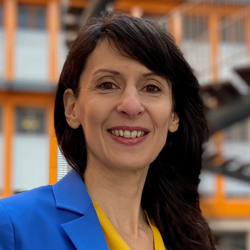
Maria Tsavachidis
CEO, EIT Urban Mobility
The smart city narrative has flipped. In the face of the climate emergency, the focus is now on ‘sustainable and inclusive’ cities — and how these can be enabled with smart tech.
The narrative around ‘smart cities’ has changed. Previously, the focus was on how new technology — such as the Internet of Things, artificial intelligence and other data-gathering innovations — could digitalise urban areas. It was missing a compelling explanation of why it was necessary and the environmental and efficiency benefits it could have.
Technology as a sustainable route
Now, the climate crisis emergency has forced governments and city planners to think in a completely different way. “Talk has moved away from ‘smart cities,’” says Maria Tsavachidis, CEO of EIT Urban Mobility, a European Institute of Innovation and Technology (EIT) initiative working to encourage positive changes in the way people move around cities. “It’s now about ‘sustainable and inclusive’ cities — and how smart technology can be used as an enabler for net zero cities and a sustainable mobility transition. There’s been a recognition that it’s the purpose of this technology that matters most.”
Take the transition to sustainable urban mobility. Digital technologies have a key role to play in this area that could include smart tolling/parking, geofencing for low-emission zones and micromobility parking. To be successful, however, Tsavachidis notes that policies must be specifically tailored to local needs.
In the move to making cities more sustainable, we must ensure that we consider everything — and everyone.
Using intelligent tech in a beneficial and impactful way
Better transport infrastructure — including cycle lanes and e-charging locations — can be created with the use of smart planning tools such as digital twins and data analytics. “Even sustainability measures that seem low-tech, such as urban design and safe cycling infrastructure, need intelligence behind them if they are to be beneficial,” explains Tsavachidis.
Once any sustainability initiative is in place, it’s vital to measure its impact (such as monitoring pollution in low-emission zones). “You can’t improve what you don’t measure,” says Tsavachidis.
Digital tools that include every person
The recent Smart City Expo World Congress, and its spin-off ‘Tomorrow.Mobility,’ defined a smart city as ‘not only forward-thinking and sustainable but fully inclusive, leaving no one behind.’ That last point is important, stresses Tsavachidis because, in the rush to make cities more sustainable, inclusivity must not fall by the wayside.
“For instance, intelligent transport information is great for people who have smartphones,” she says. “But what about older people who may not have them? We should provide them with a solution, too. In the move to making cities more sustainable, we must ensure that we consider everything — and everyone.”


